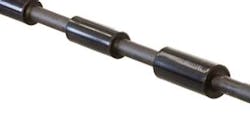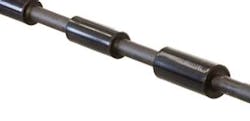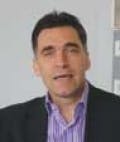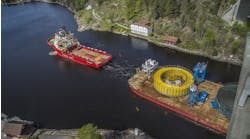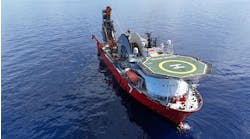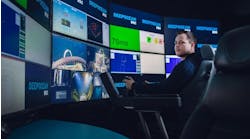Jim Redden - Contributing Editor
Mention improved or tertiary recovery and usually the first things that come to mind are injecting gas and chemicals or employing ultrasonic stimulation and other techniques to pry elusive reserves from producing wells. However, for subsea engineers the systematic development of technologies that focus on the big three of “processing, power, and pumping” hold the keys for maximizing the recovery of innumerable deepwater assets that otherwise would remain stranded.
That, says Manuel Terranova, GE Oil & Gas senior VP of subsea product platform and commercial operations, will make even comparatively small deep and ultra deepwater fields economical. While others look at near-term opportunities to increase production from existing deepwater fields, Terranova believes increasing subsea recovery over the long-term must focus on extending field life appreciably and in slashing costs, even to the point of making surface production facilities obsolete. Doing so, however, means resolving the technological hurdles of deepwater subsea processing, transmitting power for ultra long step-outs, and boosting flow through compression or pumping.
“Our vision is that the elimination of the platform has to be the long-term objective. We’re going deeper and we have all these wonderful adjacencies that can help us meet that vision, like longer step-outs, transmitting power from shore, and remote monitoring and diagnostic capabilities. We’re also working on compact subsea separation technologies for the deepwater. All of these will help enable a platform-less future,” he says.
One of the most recent attempts at doing just that is about to unfold on the Ormen Lange development off Norway where GE is set to pilot test the world’s first subsea compressor, with an aim toward producing the gas field without a platform. Developed jointly with Aker Solutions, the centrifugal compressor is driven by a gas-filled, high-speed electric motor stacked in a vertical orientation and packaged in a single sealed housing to withstand extreme hydrostatic pressure.
In the meantime, efforts also are under way to determine how to increase production from existing deepwater fields, which the US Minerals Management Service (MMS) contends have recovery factors as low as 15%. In a $1.6-million research project, funded partially by the Research Partnership to Secure Energy for America (RPSEA) public-private cooperative, Houston’s Knowledge Reservoir LLC is teaming with Anadarko Petroleum Corp. and Louisiana State University to “identify and document” improved oil recovery opportunities in the deepwater and ultra deepwater Gulf of Mexico. According to the prospectus, the project “focuses on improved recovery methods and opportunities that can be anticipated in the early stages of field development through modified surface and subsurface infrastructure design.”
That surface infrastructure is what Terranova hopes to minimize considerably or eliminate altogether. He admits, however, that taking concepts, like the one under trial at Ormen Lange, from the exceptional to the routine first requires overcoming a “multitude of issues,” not the least of which is transmitting power to ultra long step-outs. This will be especially critical in achieving the industry’s objective of eventually making deepwater and ultra deepwater fields of less than 100 MMbbl economically viable, he says.
“The primary technological gap, especially in smaller fields, is power. We have been actively looking at subsea (power) transmission and have had some early success with our subsea magnetic transmission controller. Basically, we’re trying to fill the gap between what we know will be a DC world 10 years from now, with something of value (in the near-term) that will enable the industry to go deeper with longer step-outs. An AC (controlled) step-out beyond the 90-km (56-mi) mark will be a huge breakthrough,” he says.
“We have looked hard at the correlations between deeper depths and long step-outs, so we have devoted a lot of resources into subsea tolerance and transmission and distribution. For example, we have pulled from GE’s land transmission and distribution experience and looked at how we can take that and make it easier to get power to the subsea.”
Technology transfer vital
Therein lies the key to unlocking technologies to maximize subsea production. With its experience in diverse industries, he says, GE is in a unique position to exploit its eclectic credentials and to transfer technologies from other industries into subsea production. And, armed with R&D spend that he says has tripled over the past 24 months, GE has no shortage of resources to do just that.
“I charge each of our product managers to ask themselves, ‘Where have we solved this problem before?’ or at least an analogous problem. For example, for the SemStar5 (subsea electronics module) we leveraged boards from the robotics industry. So, it’s easy to demonstrate that these are referenced technologies,” he says.
Another issue Terranova says must be resolved is subsea processing. To that end, GE Global Research in New York is teaming with its VetcoGray business to develop a subsea processing simulator with the intention of providing a network to predict the in-situ performance of compact separation components and systems over their productive field life. The $1.2-million RPSEA research program aims to develop faster and more widespread deployment of subsea processing systems.
“This is an extremely difficult problem and one the industry has been trying to solve for 15 years. It’s difficult enough to successfully model turbulent or laminar flow in a single pipeline, but the industry has figured out how to do just that even with multi-phase flow. So, how do you expand that model to a system where you have closed-loop control over fast-acting components where everything is moving quickly and dynamically?” he says.
Flow assurance critical
There also is the matter of flow assurance, which Terranova says, likewise, is essential to increase the productive life of major deepwater fields to 25 to 40 years. “Effective modeling and flow assurance will be the keys to a 40-year design life. For the larger fields, the production cycle has to be extended. So, we have to ask ourselves ‘How will I get the reliability?’ The key, I believe, is using materials science at its best.”
The issue of flow assurance is the centerpiece of an alliance with GE and SPT Group AS of Norway. The ultimate goal is to provide online flow assurance solutions based on the SPT OLGA simulator that engineers oil, gas, and water flow in wells, pipelines, and receiving facilities.
“If you are able to non-destructively model how that (subsea) system’s topology will behave you can make better prognostics on field viability and the intervention cycles that may have to be employed,” he says. “We are getting there. We already have figured out complex modeling for meteorology and oceanography and I know we will be able to do it for subsea topologies as well. This is not insurmountable.”
GE looking to other industries for subsea technology
Offshore recently met with Michael Bellamy, GM of marketing for GE Oil & Gas, at the company’s headquarters in Florence, Italy, to discuss the company’s strategy to develop technologies for the subsea market.
Offshore: One issue discussed at the Offshore Technology Conference in Houston was the transfer of technologies from other industries into the subsea market. What have you taken from the other industries you serve?
Offshore: So I gather this is the thrust of GE’s technology marketing strategy?
Bellamy: Yes. We have a program called Innovation Today. What that means is the innovations are there already. It might be new to the oil and gas industry, but it exists.
The industry always has been nervous about trying new things and we feel this will help us bridge that gap by showing while it may seem new, it really is not. These concepts and these technologies are well established in aircraft engines and other industries.
Offshore: The GE acquisitions of VetcoGray and Hydril certainly give you a significant portfolio of subsea technologies. How are those being leveraged and what areas are you concentrating on now?
Bellamy: All of our subsea technology work is based out of Houston, Aberdeen, and Norway and, yes, they really are a result of the VetcoGray/Hydril acquisitions. We are working on a number of things specific to tie-back and subsea processing. We are pilot testing the subsea gas compressor in Norway and we are developing a subsea multi-phase pump. Here, we are taking a different approach in that we really are trying to develop a subsea multi-phase pump from the ground up. Most other multi-phase pumps have been designed for onshore applications and then are adapted for the marine environment. What we’re saying is there are very specific issues with multi-phase pumps in subsea environments and we’re designing it with those in mind.
The requirements to find oil and gas are rising every year. So, the more we can beg and borrow from other industries, the better off we will be.
Offshore: How critical is subsea processing in improving subsea recovery rates, and where are we in that regard?
Bellamy: In the whole area of subsea processing, we need technologies that people feel comfortable with. I think this technology will really revolutionize the amount of production from the subsea. Once you have developed these systems and eliminated the surface facility, it just opens up so many more prospects for developments. That’s critical, because some of these finds are relatively small and you cannot afford a billion-dollar platform. So, you have to eliminate the surface facility and lower costs or these reserves are not economical.
Offshore: Geographically, where do you see the most attractive opportunities for subsea technologies?
Bellamy: The Gulf of Mexico, of course, will always be of interest and where we see a lot of activity now is still West Africa. Right now, one of the hot spots for us is in Australia and we are very optimistic about Australia and all of Asia. The reserves are there and the political will is there.
So, we are very optimistic about Australia and Brazil with drilling the presalt. We have seen a lot of good business coming from Brazil (including a recently announced three-year contract to supply Petrobras with 250 VetcoGray wellhead systems).
